Born
in Yarraville in 1904, Arnold Ernest 'Tom' Bridge came from a family of
creative thinkers. His British born father, Edward Hill Bridge
(1871-1943), was an engineer who, in 1911, patented a device for
recording telephone calls. While all three of Edward’s sons
followed in the family profession and qualified as engineers, middle
son Arnold went further and, in what was then (and is still now) an
unusual move, also qualified as an architect. In June 1919, he
became articled to city architect H V Gillespie (1888-1946), who
specialised in hotel and factory work. Concurrently with his
articles, Bridge undertook evening studies, completing courses in
architecture and building construction at the Workingmen’s College
(1919-21), engineering ('structural mechanics') at Swinburne Technical
College (1922) and unspecified studies at Footscray Technical College
(1922-23). By 1926, when Bridge enrolled in the Melbourne
University Architectural Atelier, he was employed as a draftsman in the
Architectural Department of the State Savings Bank.
By the early 1930s, Bridge had entered into partnership with architect Alan Bogle (1902-1976), evidently working from his parents’ house in Schutt Street, Newport. The practice flourished, with projects focused on the inner western suburbs where both men lived. One of their earliest was a funeral parlour in Ferguson Street, Williamstown (1931), lauded in the local press for incorporating the suburb’s first public clock. In 1933, Bridge & Bogle won second prize in a limited competition for the beautification of the Williamstown foreshore. This saw the firm retained to consult on various aspects of foreshore improvements, culminating in their design for a dressing pavilion on the Esplanade, which attracted much attention for its bold modernist style. During his time in partnership with Bogle, Bridge also assisted architect Dudley Tulloch in the production of an illustrated reference book entitled Details of Australian Building Construction, which was published in 1933. Bridge prepared a number of the drawings for the book, most notably the plans, elevations and details for a seemingly hypothetical 'proposed brick and timber residence at Main Street, Smithtown, for William Brown, esquire'.
The partnership of Bridge & Bogle appears to have dissolved by 1937, by which time Bridge and his wife Jean had moved to South Melbourne and taken up residence in a newly-complete modern block of flats at 194 Albert Road. His erstwhile partner Alan Bogle briefly practiced under his own name and went on to co-found the celebrated post-war partnership of Bogle & Banfield. Bridge, meanwhile, had also established sole practice by the late 1940s, although the precise chronology remains unclear. Although one of his first known solo projects, for a block of flats in Toorak, was published in 1945, Bridge was not listed telephone directories as an architect until as late as November 1949. The following year, he relocated his practice (styled as Arnold E Bridge & Associates) to a city address at 314 Collins Street, and then, by 1953, to 409 St Kilda Road.
During the early 1950s, Bridge’s practice seems to have focused mostly on industrial projects, which included factories in Heidelberg, Burwood and Fitzroy. In 1951, he served as consulting engineer to the Australian representatives of a British housing company, Spooners (Hull) Ltd, which sought to introduce a new type of prefabricated dwelling into the local market. During this period in sole practice, Bridge was also active in other areas, notably within the Australian Planning Institute. A brief stint as the body’s acting Honorary Secretary (1945) was followed by successive stints as vice-president (1946-47) and finally president (1947-48).
In 1949, Arnold Bridge employed a young recently-arrived migrant named Anthony Hayden (1921-1984), who was born in Poland but trained as an architect in England. After six years in Bridge's office, Hayden was elevated to full partnership in the firm subsequently known as Bridge, Hayden & Associates. During its heyday of the 1950s and '60s, the firm was mostly involved in medium-scaled retail, commercial and industrial projects. Factory commissions, which had defined Bridge’s practice from the late 1940s, continued to be a recurring theme. One significant client was the Dickin's New World grocery chain (later taken over by G J Coles), for whom the architects carried out several projects. They were responsible for the design of Melbourne’s first modern American-style drive-in supermarket, erected in Balwyn North in 1959, followed by others at Preston, Ballarat and elsewhere. The practice also undertook residential work, including individual dwellings as well as larger apartment blocks.
Arnold Bridge retired in 1973, but his practice continued under the name of Anthony A Hayden & Associates. Bridge died of an aortic aneurysm on 20 May 1980, aged 76 years.
By the early 1930s, Bridge had entered into partnership with architect Alan Bogle (1902-1976), evidently working from his parents’ house in Schutt Street, Newport. The practice flourished, with projects focused on the inner western suburbs where both men lived. One of their earliest was a funeral parlour in Ferguson Street, Williamstown (1931), lauded in the local press for incorporating the suburb’s first public clock. In 1933, Bridge & Bogle won second prize in a limited competition for the beautification of the Williamstown foreshore. This saw the firm retained to consult on various aspects of foreshore improvements, culminating in their design for a dressing pavilion on the Esplanade, which attracted much attention for its bold modernist style. During his time in partnership with Bogle, Bridge also assisted architect Dudley Tulloch in the production of an illustrated reference book entitled Details of Australian Building Construction, which was published in 1933. Bridge prepared a number of the drawings for the book, most notably the plans, elevations and details for a seemingly hypothetical 'proposed brick and timber residence at Main Street, Smithtown, for William Brown, esquire'.
The partnership of Bridge & Bogle appears to have dissolved by 1937, by which time Bridge and his wife Jean had moved to South Melbourne and taken up residence in a newly-complete modern block of flats at 194 Albert Road. His erstwhile partner Alan Bogle briefly practiced under his own name and went on to co-found the celebrated post-war partnership of Bogle & Banfield. Bridge, meanwhile, had also established sole practice by the late 1940s, although the precise chronology remains unclear. Although one of his first known solo projects, for a block of flats in Toorak, was published in 1945, Bridge was not listed telephone directories as an architect until as late as November 1949. The following year, he relocated his practice (styled as Arnold E Bridge & Associates) to a city address at 314 Collins Street, and then, by 1953, to 409 St Kilda Road.
During the early 1950s, Bridge’s practice seems to have focused mostly on industrial projects, which included factories in Heidelberg, Burwood and Fitzroy. In 1951, he served as consulting engineer to the Australian representatives of a British housing company, Spooners (Hull) Ltd, which sought to introduce a new type of prefabricated dwelling into the local market. During this period in sole practice, Bridge was also active in other areas, notably within the Australian Planning Institute. A brief stint as the body’s acting Honorary Secretary (1945) was followed by successive stints as vice-president (1946-47) and finally president (1947-48).
In 1949, Arnold Bridge employed a young recently-arrived migrant named Anthony Hayden (1921-1984), who was born in Poland but trained as an architect in England. After six years in Bridge's office, Hayden was elevated to full partnership in the firm subsequently known as Bridge, Hayden & Associates. During its heyday of the 1950s and '60s, the firm was mostly involved in medium-scaled retail, commercial and industrial projects. Factory commissions, which had defined Bridge’s practice from the late 1940s, continued to be a recurring theme. One significant client was the Dickin's New World grocery chain (later taken over by G J Coles), for whom the architects carried out several projects. They were responsible for the design of Melbourne’s first modern American-style drive-in supermarket, erected in Balwyn North in 1959, followed by others at Preston, Ballarat and elsewhere. The practice also undertook residential work, including individual dwellings as well as larger apartment blocks.
Arnold Bridge retired in 1973, but his practice continued under the name of Anthony A Hayden & Associates. Bridge died of an aortic aneurysm on 20 May 1980, aged 76 years.
Select List of Projects
Bridge & Bogle
| 1931 1933 1934 1935 | Funeral parlour for E W Jackson, 91 Ferguson Street, Williamstown Scheme for beautification of foreshore, Williamstown (competition entry) Dressing pavilion, The Esplanade, Williamstown Residential shops, Williamstown |
Arnold E Bridge & Associates
| 1945 1947 1950 1952 1954 | Flats, Lascelles Avenue, Toorak Factory for E G Greenway Pty Ltd, 127 Whitehorse Road, Blackburn Factory for Morris & Walker, Heidelberg Factory for Warburton Franki Ltd, Burwood Additions to factory for Spicer Shoe Company, Queens Parade, Fitzroy North |
Bridge, Hayden & Associates
| 1956 1957 1958 1959 1960 1962 1964 1966 1967 1969 | Showroom, Victoria Street, Abbotsford Factory for Precision Mower Services Pty Ltd, 977 Mount Alexander Road, Essendon Flats and offices, 50 Queens Road, Melbourne Factory for Ravdell Tyre & Rubber Company, 449-453 Bridge Road, Richmond Additions to factory for Slade Brothers Knitting Mills, 102 Dover Street, Richmond Factory for Kenneth Wright Pty Ltd, 95-103 Johnston Street, Fitzroy Additions to factory, Lusher Road, Croydon Synagogue for Caulfield Hebrew Congregation, 572 Inkerman Street, Caulfield Supermarket for S E Dickins Pty Ltd, 1 Doncaster Road, Balwyn North Supermarket for S E Dickins Pty Ltd, Bridge and Greville Streets, Ballarat Motor showroom, St Kilda Road, St Kilda Flats, Vincent Street, Surrey Hills House, Cleve Court, Toorak Synagogue for Kew Hebrew Congregation (Bet Nachman), 53 Walpole Street, Kew Retail fitout for S E Dickins Pty Ltd, Chadstone Shopping Centre, Chadstone Flats, Hornby Street, Prahran Shops and offices (Carlisle House), 320-336 Carlisle Street, St Kilda East Factory for Teena Lingerie, 5 Pitt Street, Brunswick Residence, Helenslea Road, Caulfield North Residence, Balwyn Flats, Maple Grove, Toorak Residence, Hawthorn Flats, Riversdale Road, Hawthorn |
top
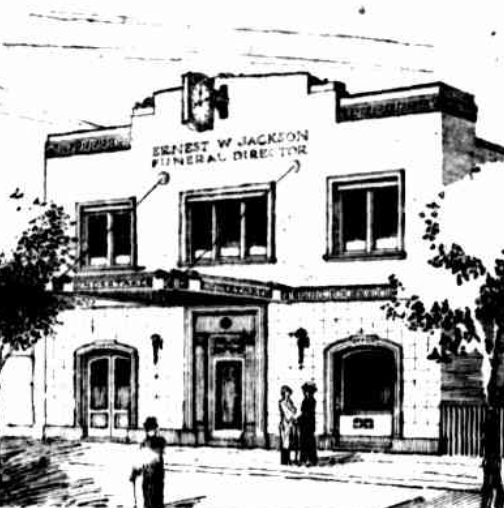 | |
| Funeral parlour, Williamstown, by Bridge & Bogle (1931) |
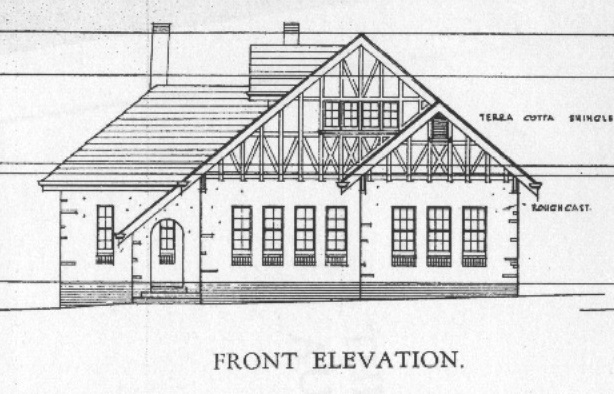 | |
| Scheme for house by Arnold E Bridge (1933) |
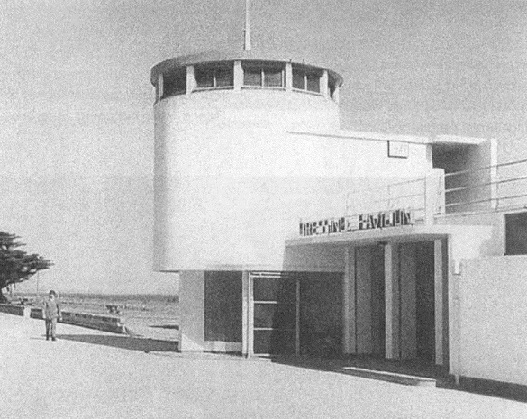 | |
| Dressing pavilion, Williamstown, by Bridge & Bogle (1934) (source: Spirit of Progress, Autumn 2006) |
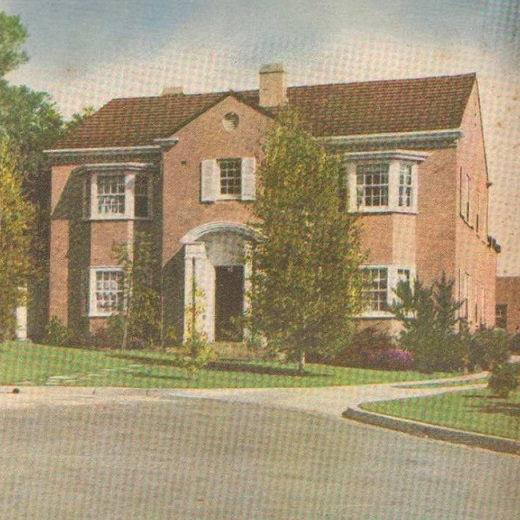 | |
| Flats at Toorak by Arnold E Bridge (1945) |
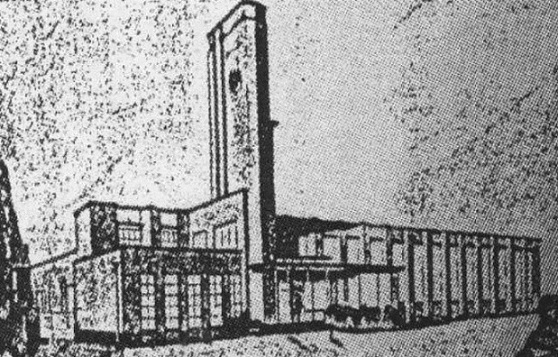 | |
| Factory at Blackburn by Arnold E Bridge (1947) |
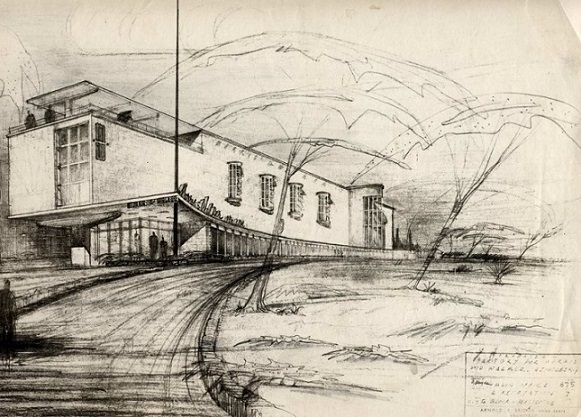 | |
| Factory at Heidelberg by Arnold E Bridge (1950) |
| Further Reading Fay Woodhouse, "Alan Bogle: A Brief Biography", Spirit of Progress, Autumn 2006, pp 10-12. |
